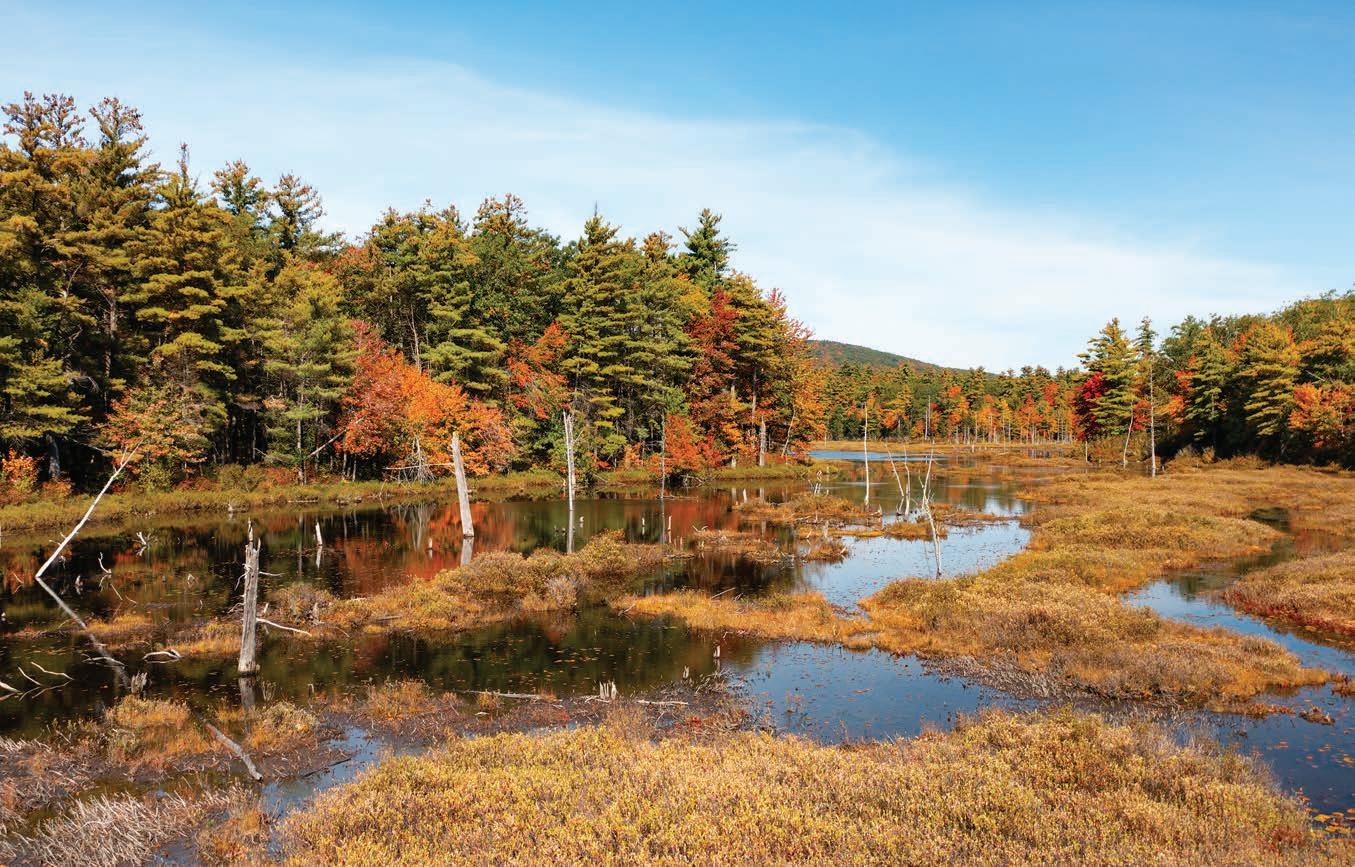Northeast Wilderness Trust

2024 Annual Report



2024 Annual Report

Across the Northeast, the whispers of wilderness are growing louder. They tell stories of resilience, rebounding wildlife populations, and the boundless hope found in wild Nature’s many enduring values.
At Northeast Wilderness Trust, we see hope not as an end but as a spark—one that drives meaningful work to advance wilderness recovery.
In 2024, the Wilderness Trust continued its work turning hope into tangible results. Through collaborative partnerships and the dedication of supporters, the Wilderness Trust permanently protected more than 14,000 acres as forever-wild. More than a number or statistic, these rewilding places store abundant carbon, offer contemplative space for human visitors, and, most vitally, are the homes of our wild kin.
Nature’s creative, restorative work of healing ecological wounds is often called “passive rewilding”—but a rewilding approach to land conservation demands deliberate action. It challenges us to adopt the long perspective of “tree time” rather than the immediacy of human timescales. It requires us to create the place and space for natural processes to play out. And it invites us to embrace radical humility, recognizing that there ought to be some places where the land community teaches us what it wants to be—by evolving and adapting free of human intervention.
This is precisely the work of Northeast Wilderness Trust. In the following pages, you will read stories about this past year’s results of our shared commitment to a wild future—to Rewilding the Northeast.
These stories highlight real places, both large—such as the expansive 6,700-acre Mountain Brooks Wilderness Preserve in Maine—and small, like the 254-acre Little River Wilderness Preserve in New York. They illustrate what is possible when we move beyond imagining a wilder future to creating one. And from a single youngster and a generous couple to a group of committed volunteers, people are coming together to realize that shared vision.
With every acre protected, every habitat secured, and every voice added to this wild movement, we’re putting down the roots of tomorrow’s old-growth forests. I can’t think of anything more hopeful than that.

Jon Leibowitz, President and CEO
Northeast Wilderness Trust’s conservation successes do not happen by accident. The constellation of forever-wild preserves and conservation easements on the adjoining map are the result of a steadfast commitment to Nature and a vision for a wilder future.
Still, as for any organization, the Wilderness Trust cannot pursue every acquisition opportunity that arises in New England and New York. So how does the Land Conservation team choose the projects on which to focus its resources?

Potential projects are graded using a rubric of property-specific and wider geographical and biological factors. For example, a parcel might be evaluated on its adjacency. Does it border another Wilderness Trust preserve? Other conserved lands? Another criterion measures intactness. Is the property fragmented
by roads? Yet another considers the land’s history, especially as concerns forest management. Other factors consider the property through a wider lens. Connectivity and resilience are paramount here. Does the prospective preserve bolster a recognized wildlife corridor? Does it feature topographical diversity, providing vertical mobility for species that may seek high-elevation habitat in response to rising temperatures?
No project receives a perfect score across the board. A highly fragmented tract might boast rare stands of old growth; an intact one might be located in a highly developed area scoring poorly on the connectivity scale. None of these factors is assessed in a vacuum. Instead, projects are pursued (or not pursued) based on their aggregated conservation value. Higher values indicate projects that better advance the organization’s overarching goal, codified in the 2025–2030 Strategic Plan, of a vibrant, connected landscape of conserved wildlands. Thanks to the hard work and generosity of many, the results showcased on the accompanying map signal a hopeful future for wilderness conservation in the Northeast.

MASSACHUSETTS
Baxter State Park
FOREVER-WILD PLACES PROTECTED BY NEWT
Forever-Wild Place
Conserved in 2024

Other Protected Wilderness*
*GAP 1 and 2 status: Permanently Secured for Nature and Natural Processes, per TNC Secured Areas Database
Northeast Wilderness Trust’s philosophy is to ensure long-lasting, durable wilderness conservation. This “belt-andsuspenders” approach involves two layers of legal safeguards on every conserved acre.
The second layer of protection on every Wilderness Trust preserve, bolstering the first layer of direct ownership, is a foreverwild conservation easement. The Wilderness Trust conveys these easements on its lands to partner organizations that share its belief in the power of rewilding and in the need for wildlands to constitute a greater share of the Northeast’s conserved lands. In 2024, four of these “double-layer” conservation easements were conveyed to local land trusts like the St. Lawrence Land Trust in New York, and to national organizations like The Nature Conservancy.
The Wilderness Trust not only conveys forever-wild conservation easements; it also accepts them. The primary strategy to achieve this outcome is through the Wildlands Partnership, a one-of-akind program that provides financial and other forms of support to land trusts that convey forever-wild easements to the Wilderness Trust. Last year, thanks to partners Cornwall Conservation
Trust and Norfolk Land Trust, three Wildlands Partnership easements totaling more than 1,000 acres in northwestern Connecticut were added to the Wilderness Trust’s wild legacy.
Another example of this approach last year was the donation of two parcels to the Native Land Conservancy (NLC), an Indigenous-led land trust in Massachusetts. NLC is now in the process of conveying forever-wild easements on these parcels to the Wilderness Trust, in keeping with the organizations’ mutual goals of reverence for the land and its permanent protection.
This two-step conservation strategy helps ensure a key outcome of the Wilderness Trust’s conservation work: durability. Land conserved as foreverwild by Northeast Wilderness Trust and partners stands the best chance to stay wild indefinitely, providing habitat for wildlife, solace for people, and carbon storage for the planet.
In 2024, the Wilderness Trust conveyed forever-wild conservation easements on its Grasse River (left) and Eagle Mountain (right) Wilderness Preserves, both in New York State.
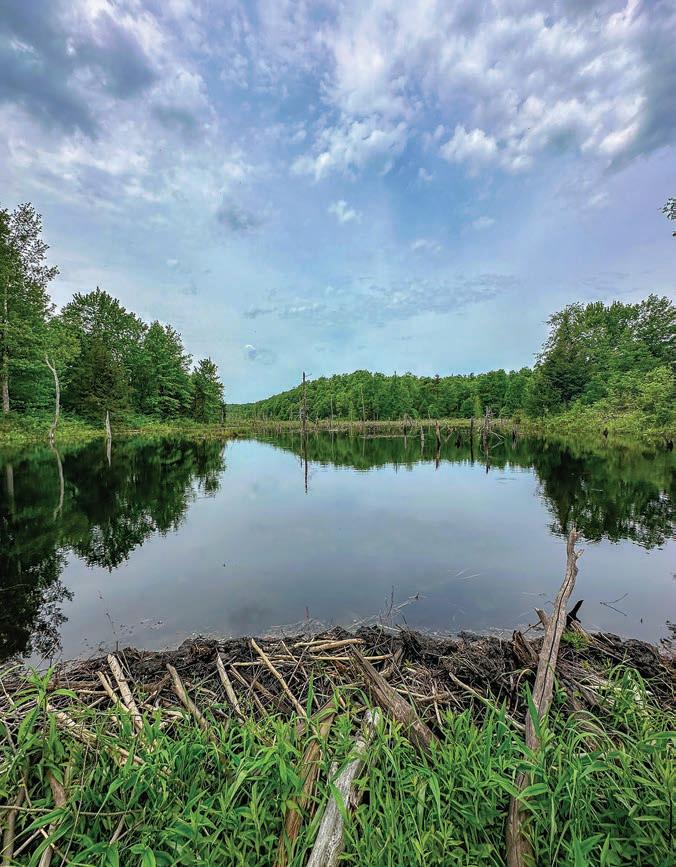

2,308 acres of wetlands


40 miles of rivers and streams

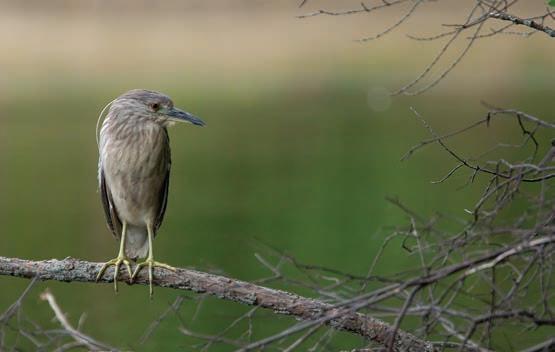
9,900 acres of designated Important Bird Areas

1,789,008 metric tons of carbon stored

100,000
93,188 acres
75,000
50,000
25,000

At 6,730 acres, Mountain Brooks Wilderness Preserve is Northeast Wilderness Trust’s largest-ever land acquisition. Situated along Maine’s border with New Hampshire, the Preserve rises more than 2,000 vertical feet from its lowest point and encompasses several peaks in the White Mountains’ Mahoosuc Range, as well as four major waterways and various smaller brooks and streams.
These land and water features offer ample habitat for imperiled species.
Maine’s Beginning with Habitat initiative indicates that the property is home to the Bicknell’s Thrush and Peregrine Falcon, both of which are state endangered species, as well as the state threatened Blackpoll Warbler. The Preserve also boasts many exposed cliffs, which may have overhangs and crevices that serve as hibernacula for Maine’s ailing bat species.
These creatures benefit not only from the Preserve itself, but also from its broader conservation context. To the Preserve’s north are Maine’s nearly 10,000-acre Mahoosuc Ecological Reserve and the Wilderness Trust’s roughly 6,000-acre Grafton Forest Wilderness Preserve, while to its southwest is the White Mountain National Forest. Also nearby are extensive National Park Service lands surrounding the Appalachian Trail. Forever-wild conservation of the Mountain Brooks Wilderness Preserve adds vital wilderness to mountainous western Maine, ensuring that this ecologically vibrant region remains so into the future.

Riley Township, Maine
6,730 acres
Largest acquisition in Wilderness Trust history
Protects documented habitat of state endangered species

The 3,399-acre Birch Stream Wilderness Preserve hosts a spectacular diversity of wildlife habitat—from wetlands and waterways to upland forests and spruce bogs. Protection of this property by Northeast Wilderness Trust ensures that the wild inhabitants here, including moose, black bear, beaver, and coyote, will forever have an untrammeled home.
But there is another important benefit of sparing this land from future logging and development. Beneath the more than 2,000 acres of wetlands at Birch Stream is a massive carbon sponge: peatlands. These are ecosystems of sedges, mosses, and shrubs created when drenched soils prevent dead plant material from fully decomposing. The Preserve’s peatlands and its plentiful forests make the property a terrific example of forever-wild conservation as a natural climate solution.
Zooming out, Birch Stream sits in a region of Maine underrepresented in wilderness conservation. The Preserve is the first forever-wild holding secured in this largely unfragmented forest block identified by experts as of the highest priority for conservation. Many of the streams and brooks here are mapped as critical habitat for Atlantic salmon and alewife.
Abutting the property on its southern edge is a nearly 10,000-acre tract owned and managed principally for wildlife by the Penobscot Nation. Together, these factors affirm conservation of Birch Stream as a hopeful step towards the Wilderness Trust’s vision of a landscape of geographically diverse and connected conserved wildlands that benefit Nature and people.
3,399 acres
Situated in a region of highest conservation priority
Includes more than 2,000 acres of intact wetlands


Rare or threatened understory plant species get a reprieve at the Great Oaks Wilderness Sanctuary. This 534-acre property in Parsonsfield, Maine showcases exemplary Northern Hardwood Forest as it descends from the summit of Dearborn Mountain down to the shoreline of West Pond, where overhanging shade trees and underwater woody debris benefit breeding fish and amphibians.
True to its name, the Sanctuary also hosts thick, towering oaks, along with massive white pines along the pond’s shore. Ample fallen trees, standing dead trunks, and hollow stumps and logs provide denning, foraging, and nesting habitat for a variety of wildlife, including weasels, songbirds, bears, and coyotes. At least nine rare or threatened understory plant species are found on the land, including Back’s sedge, blunt-lobed woodsia fern, and Fogg’s goosefoot.
Many of the habitats on Great Oaks are already well on their way to ecological complexity, thanks to the respect and care shown to the property by the Preserve’s former owners, the Lougee family. When the Lougees conveyed the parcel to Northeast Wilderness Trust, they ensured that the land multiple generations of their family have adored will remain wild and vibrant into the future, while also bolstering the area’s landscape connectivity and climate resilience.

534 acres
Features forests uncut since at least the 1940s
Protects habitat for nine rare or threatened plant species
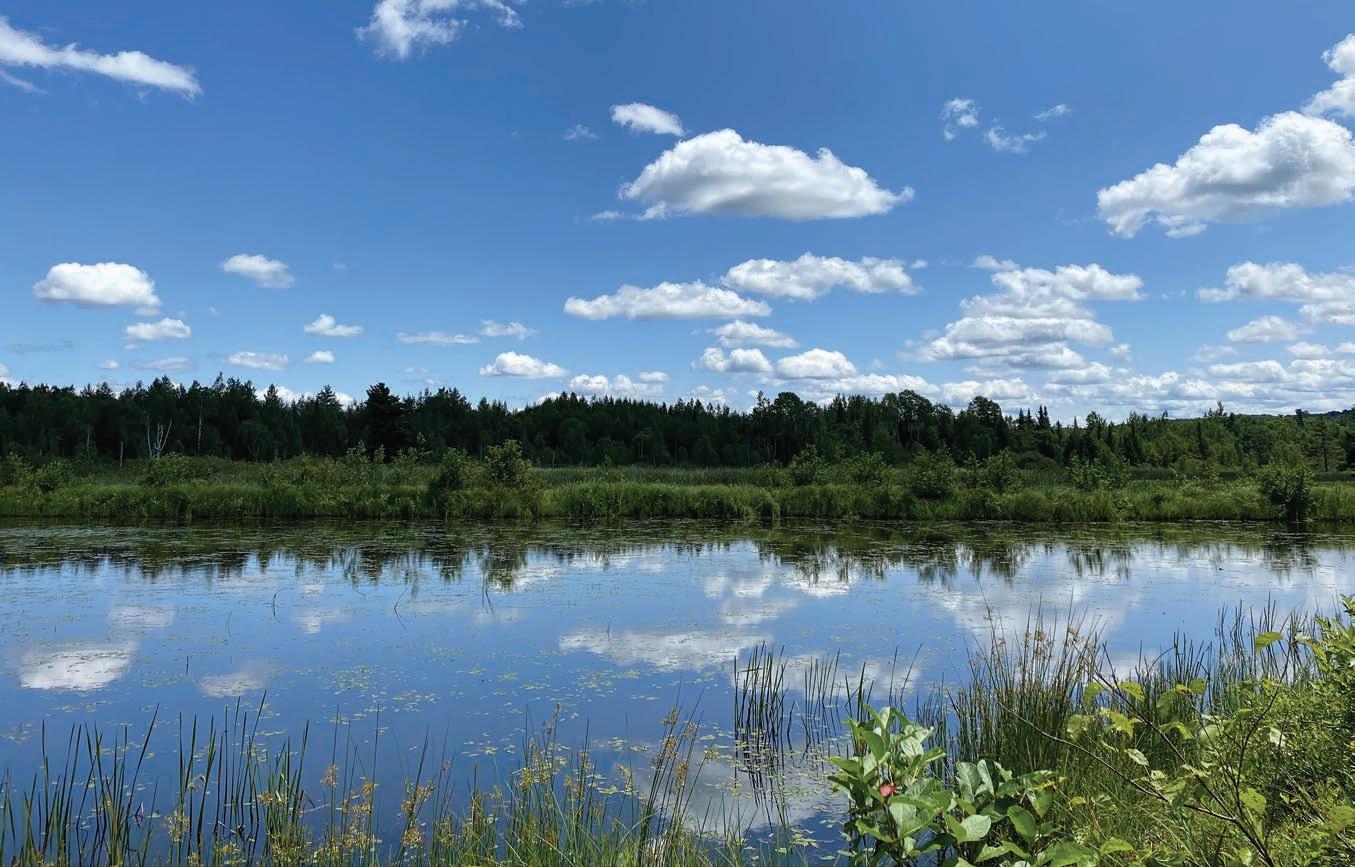
Conserving land in the Algonquin to Adirondacks (A2A) wildlife corridor, identified as one of the few remaining large-scale habitat linkages in the East, has been a Northeast Wilderness Trust priority for several years. As temperatures rise, wide-ranging species like moose, bobcat, and many songbirds need the habitat connectivity provided by corridors like the A2A to shift their ranges north and to adapt to changing ecological conditions.
2024 represented a step towards that broader goal with the protection of Little River Wilderness Preserve. This 254-acre parcel, just north of one of the Adirondack Park’s wildest places, features more than 70 acres of wetlands, miles of streams, and approximately half a mile of the Little River, all of which support a wide range of species and natural communities. The property has been largely undisturbed for many decades, leaving its forests and wetlands in exceptional condition.
The Preserve abuts the 107,000 acres of the Five Ponds Wilderness Area, one of the largest and most remote landscapes in the Northeast. And with its location within the A2A wildlife corridor, Little River Wilderness Preserve’s forever-wild protection showcases the value of incremental progress in the Wilderness Trust’s landscape-level conservation and wildlife connectivity ambitions.
Star Lake, New York
254 acres
Falls within the A2A wildlife corridor
Abuts the 107,000-acre Five Ponds Wilderness Area
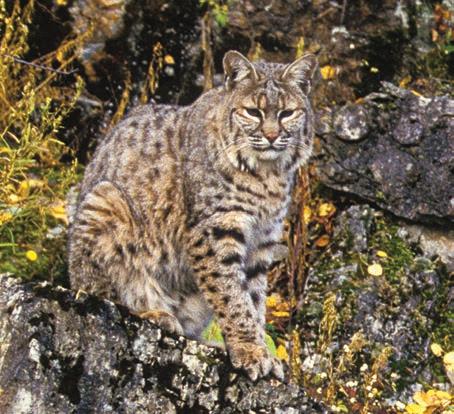
An overarching goal of Northeast Wilderness Trust’s work is to help create a more ecologically connected Northeast, as exemplified by ongoing conservation work at the Bear’s Nest Wilderness Preserve.
“Phase II” of Bear’s Nest brings nearly 2,000 additional acres under forever-wild protection. The Preserve sits along the northern Green Mountains, which the Staying Connected Initiative has identified as one of the wildest but least-protected regions in the Northeast. Though the property has a history of active management, some portions exhibit old-forest characteristics. The property’s steep gradient provides vertical space for species to migrate upward as temperatures rise. Moreover, Bear’s Nest falls within the Northern Greens to Canada wildlife corridor—

ensuring that the impact of this forested gem achieves landscape conservation at both the regional and cross-border levels. The recently acquired addition to Bear’s Nest Wilderness Preserve was previously owned by Vermont Land Trust (VLT) and The Nature Conservancy (TNC). The sale of the property to the Wilderness Trust, along with the forever-wild conservation easement that the Wilderness Trust will convey to TNC, reshaped its future. The Bear’s Nest Wilderness Preserve project underscores the value of collaboration and highlights the growing recognition among conservation organizations of the virtues of rewilding.
2,716 acres
Expanded by nearly 2,000 acres in 2024
Within the Northern Greens to Canada wildlife corridor

Northeast Wilderness Trust’s Woodbury Mountain Wilderness Preserve holds the distinction of being the largest non-governmental wilderness area in Vermont. Two additional conservation successes in 2024 bolstered the Preserve’s wild impact.
In May, the Wilderness Trust acquired a 160-acre forested parcel that expands the Preserve on the Elmore side of the town boundary with Woodbury. The Elmore Branch Addition features vibrant wetlands and stream frontage shaded by hemlocks, which keep the water cold and well oxygenated for populations of wild brook trout. The Addition also strengthens Woodbury Mountain’s position as a key piece of the approximately 1-million-acre Worcester Range to Northeast Kingdom Linkage, which has been identified by the Staying Connected Initiative as encompassing “some of the most wild, intact forested areas in the state.”
To strengthen its forever-wild status, the Wilderness Trust conveyed a conservation easement on the full property to Vermont River Conservancy (VRC). The easement represents VRC’s largest-ever conservation project and advances the Wilderness Trust’s goal of bringing new partners into the rewilding movement.
Woodbury, Elmore, Worcester, and Hardwick, Vermont
6,257 acres
Expanded in 2024 by the Elmore Branch Addition Largest non-governmental wilderness area in Vermont
Northeast Wilderness Trust is not just working to create more wilderness areas across the region but is building a rewilding movement by working to mainstream forever-wild conservation among partner organizations and practitioners. The flagship for generating this groundswell is the Wildlands Partnership, a collaborative endeavor that aims to bring land trusts in the Northeast into the forever-wild fold. In exchange for project funding and other forms of support, participating organizations agree to convey a forever-wild easement on their land to Northeast Wilderness Trust. Partner land trusts get a financial and technical boost, and the Northeast gets more legally protected wildlands.
The second phase of the Partnership continued in 2024, with seven land trusts enrolled in the program. Two of these land trusts, both in northwestern Connecticut, finalized their Wildlands Partnership conservation easements last year. One, Cornwall Conservation Trust, has previously worked with the
Wilderness Trust to protect land in Litchfield County. Another, Norfolk Land Trust, is a first-time participant in the Partnership, and has added 600 acres of forever-wild forest to its holdings via the new South Norfolk Wildlands conservation easement.
When the remaining Phase II projects close next year, they will contribute 4,000 forever-wild acres to the Northeast’s wildlands, increasing the total acreage conserved via the Partnership to more than 14,000.
Last year also marked the completion of the application stage of the Partnership’s third phase. The strong continued interest in the program promises to further expand rewilding’s reach in the conservation world and permanently protect thousands of additional acres of forever-wild land across the region.
Scenes from Cornwall Conservation Trust conservation easement (left) and South Norfolk Wildlands conservation easement (right)

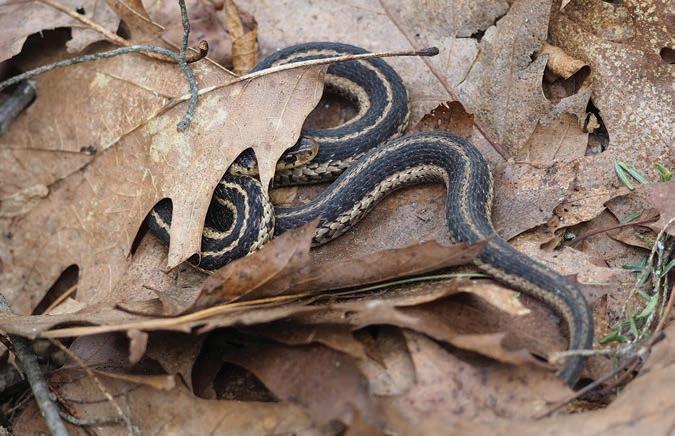
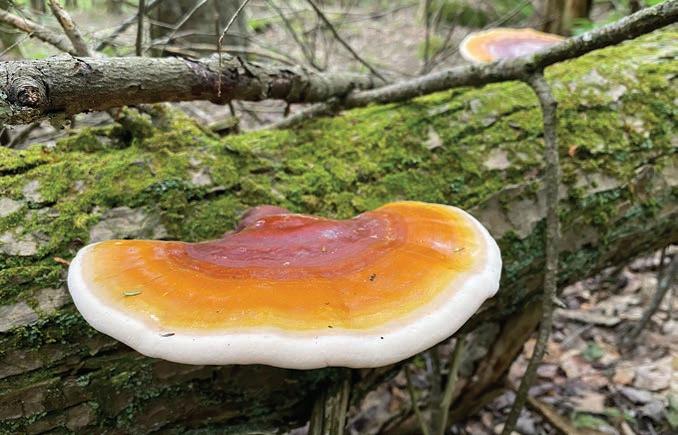

In 2024, Northeast Wilderness Trust and its partners made great strides toward the development of a region-wide wildlands conservation framework, aimed at helping conservation organizations prioritize future wilderness protection and connection efforts in the Northeast. Wildlands Ecology Director Shelby Perry teamed up with colleagues from the Wildlands, Woodlands, Farmlands & Communities (WWF&C) partnership and Vermont Fish and Wildlife to build on the groundbreaking 2023 report, “Wildlands in New England: Past, Present, and Future.” The report quantified the region’s wild places and the durability of their legal protections, with a sobering conclusion: though 81 percent of New England is forested, just over 3.3 percent is protected as wildlands, far short of the WWF&C goal of 10 percent wildlands in the region.

Among the existing wildlands, some ecoregions and natural communities are better represented than others. This trend, which grows out of a mix of factors including human settlement patterns, land values, and politics, has resulted in the absence of certain species and natural communities, especially lowland systems, on conservation lands.
To combat this imbalance, in 2024 the partners began identifying the least-protected ecoregions and ecosystem types in New England and New York as a first step towards boosting their share of the region’s wildlands. The undertaking has already produced illuminating data. Just looking at Vermont as an example, high-elevation ecoregions and natural communities, such as the Southern Green Mountains and the Acadian-Appalachian Montane Spruce-Fir Forests, are well on their way to the conservation targets laid out by “Vermont Conservation Design.” Meanwhile, lower-elevation ecoregions and natural communities, like the Champlain Hills in western Vermont and Appalachian (Hemlock)-Northern Hardwood Forest, lag far behind their high-elevation counterparts in wildlands protection. These Eastern hemlock
New England’s forested and conserved landscape belies a relative scarcity of forever-wild conservation in the region.
Data from “Wildlands in New England” Report, 2023
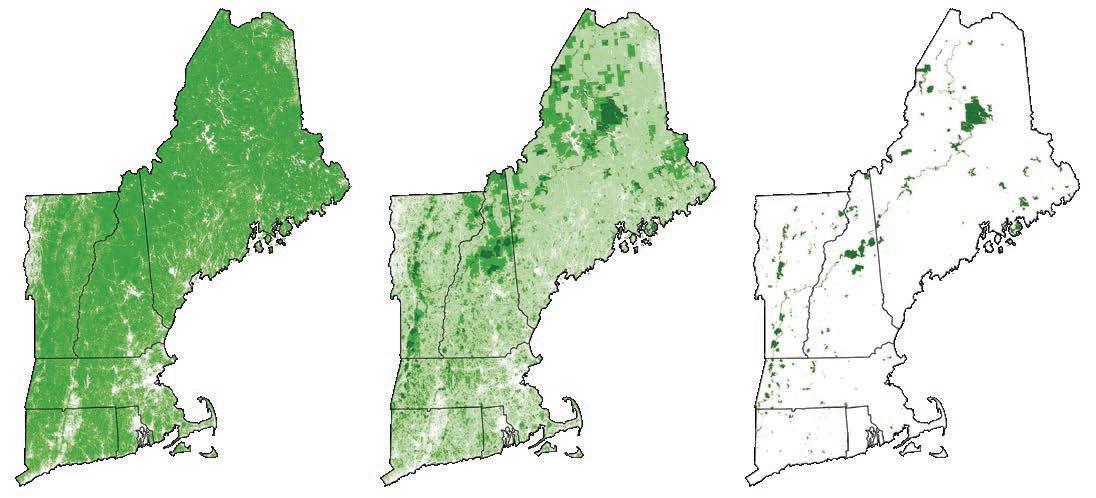
underrepresented areas are also more common in southern New England, where wildlands as a whole are less extensive than in Vermont, New Hampshire, Maine, and especially New York.
The stark disparities revealed by the project highlight the challenges researchers and conservation planners face as they
work not only toward a New England of plentiful wildlands, but of ecologically and geographically diverse and connected ones.
Conservationists across New England can incorporate these data into their decision-making as they pursue a protected regional landscape reflective of New England’s rich biodiversity.
Land stewards are the unsung heroes of Northeast Wilderness Trust. Despite the organization’s passive approach to rewilding—giving Nature the freedom to do as it has done for millions of years— Wilderness Trust stewards frequently undertake projects aimed at removing lingering traces of human influence from the land. This is part of the commitment to keeping Wilderness Trust preserves and easements “untrammeled” for the benefit of wildlife and respectful human visitors alike.
The stewards often go about this work alone, but sometimes they get help from an extra set of hands—and sometimes many! Last year, an intrepid group of volunteers from Church & Dwight Corporation (C&D), a longtime supporter of the Wilderness Trust, trekked to Bear’s Nest Wilderness Preserve in northern Vermont to see firsthand how the stewards accelerate the rewilding process via trammel removal. Bear’s Nest’s 2,700-plus acres are largely wild, but traces of industrial impact remained. Those included a shack and many miles of plastic tubing and other materials used in a past maple-sugaring operation.
After a quick orientation, the C&D volunteers split into groups and began collecting tubing and rusty sap buckets, while others deconstructed the sugar shack. By mid-afternoon, a massive tangle of tubing, a pile of treated boards, and a mess of buckets, metal sheeting, and other debris lay alongside the road out of the Preserve, ready to be taken away. Vermont Land Steward Sophie Ehrhardt noted that the volunteers accomplished in a day what would have taken her weeks to complete. Meanwhile, the group came away with the satisfaction of a job well done, and a better sense of the ways in which Northeast Wilderness Trust stewards fulfill the promise of untrammeled landscapes. Bear's





At just 8 years old, Emma S. from Addison County, Vermont might be Northeast Wilderness Trust’s youngest supporter. Her 2024 donations of $31 and $90.89 (funded through Christmas money and bake sales with her friend Lilli) are a source of hope and inspiration for the future. As Henry David Thoreau famously said: “Convince me that you have a seed there, and I am prepared to expect wonders.”
Emma, whose heroines are climate and environmental activists Greta Thunberg and Julia Butterfly Hill, learned about the Wilderness Trust’s work through a neighbor and decided to act.
“I heard that Northeast Wilderness Trust keeps Nature more wild, and that’s what I’m interested in. There’s too much plastic and litter in our world and Nature is better without it. My school has an outdoor classroom and ‘Forest Friday’ where we read books about Nature and play in the woods. I really like it.”

An eastern hemlock can live for eight hundred years. The lands we safeguard give these trees, and the entire land community, the chance to live out their lives with minimal human disruption. Through the Ancient Forest Society, generous individuals and families step forward to create a living legacy by providing for a gift to Northeast Wilderness Trust as part of their estate plans. Supporters Bill Roper and Barbara Ganley are inspired to give back to Nature by the gifts they feel they have received over the course of their lives.
Barbara shares, “As a child I spent summers roaming a wild stretch of the Maine coast tracking animals through the woods, swimming in a tidal creek, watching ospreys dive into huge schools of fish churning the bay. I didn’t know how important such places were until later when this haven of my youth was subjected to real estate development. If only there had been Northeast Wilderness Trust in those days! Supporting and engaging with the Wilderness Trust feels like a joyful, necessary action in my life, and every time I read of one more such wild place saved my wild heart sings again.”

And Bill reflects, “Growing up loving the outdoors led me to a career in conservation and land-use planning. The Wilderness Trust’s clarion call drew me to join its amazing Board and work with its exceptional staff during a time of organizational growth and increased impact around the Northeast. Naming Northeast Wilderness Trust in our wills gives us the joy of knowing that we are partners for perpetuity in the care of future old-growth forests across the region.”
If you would like to share a provision in your will or have a question about gift planning, please call or email Nicie Panetta, Vice President of Advancement at 802-224-1000 ext. 111 or nicie@newildernesstrust.org. Thanks to the members of the Ancient Forest Society, the Wilderness Trust is in a position to keep its promises to forests in our care for generations to come.
Northeast Wilderness Trust continued to grow and strengthen its financial position in the fiscal year ending June 30, 2024. From an operating perspective, unrestricted giving reached a new high. Thanks to extraordinary support from a growing community of donors, the Wilderness Trust posted a strong operating surplus, which was invested in its emergency Operating Reserve Fund. In fiscal year 2025, in concert with a new 2030 Strategic Plan, the Wilderness Trust will be investing in its talented and dedicated staff to achieve the goals of the plan and ensure long-term financial sustainability. The Wilderness Trust’s balance sheet remained strong, with a healthy cash position and no debt. The Wilderness Trust works to balance a sense of urgency in responding to the need for new wilderness areas across the region with a commitment to prudent financial management.

Summary Statement of Financial Position at June 30, 2024
$56,259,815
Summary Statement of Income and Expense at June 30, 2024
Income
Contributions and Grants
Northeast Wilderness Trust Corporation was incorporated in 2002 in Vermont as a 501(c)3 organization. All contributions to the Wilderness Trust are tax-deductible to the fullest extent of the law. Audited financial statements available upon request.
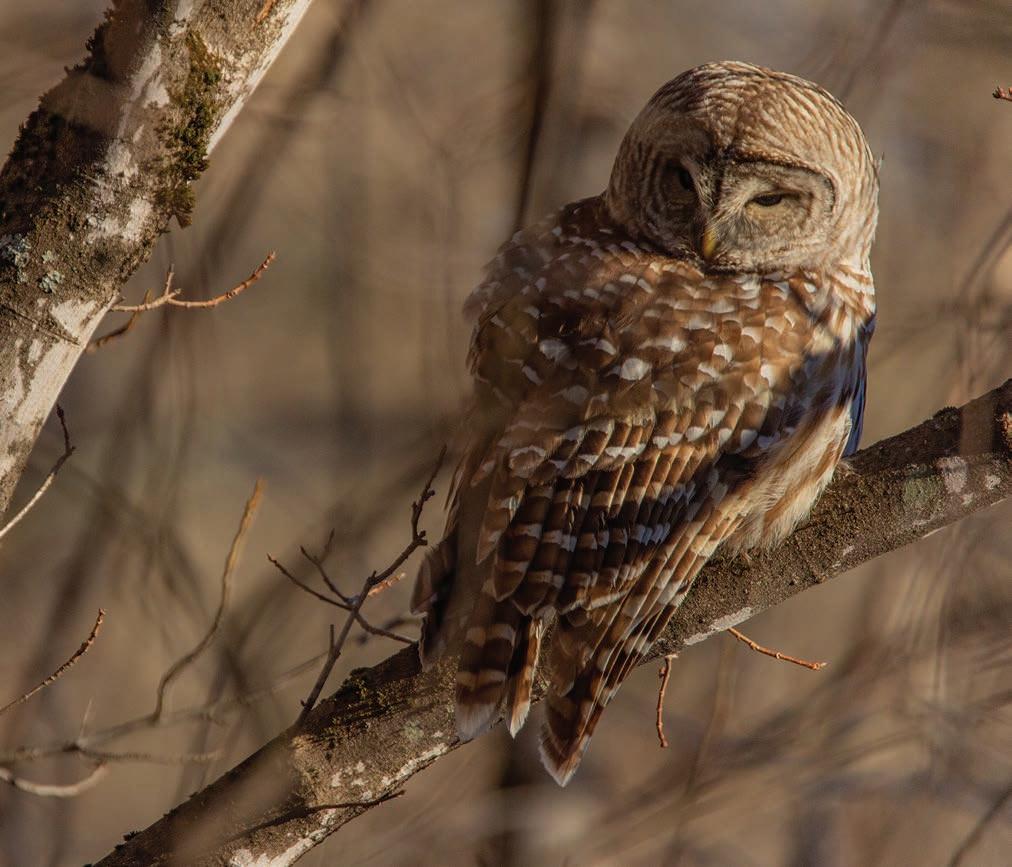
Aram Calhoun Aram is Professor Emerita of Wetland Ecology and Conservation in the Department of Wildlife, Fisheries, and Conservation Biology at the University of Maine. Based in Maine, her research focuses on wetland conservation, in particular how vernal pools function as keystone ecosystems.


Bill Roper Bill has dedicated his professional and personal life to landscape conservation, inclusive community engagement, and sound land-use planning. Based in Vermont, he is an environmental attorney and served as the former head of the Orton Family Foundation and as a community watershed-resilience consultant at High Meadows Fund.

Alan Jutras Alan brings many years of experience in conservation finance to the Wilderness Trust. He is a managing director in the audit practice of a large international audit, tax, and advisory firm where he oversees audits for nonprofit and private organizations. Alan is based in Massachusetts.

Mark Zankel Mark serves as the Director of Community Solar at ReVision Energy, a 100-percent employee-owned company working to make life better by building our just and equitable electric future. Mark, who lives in New Hampshire, previously spent 28 years at The Nature Conservancy, serving as the New Hampshire Chapter’s Director of Conservation Programs and then as State Director.

Jonathan Leibowitz, VT President and CEO
Brian Tijan, VT Chair
Susie O’Keeffe, ME Vice Chair
Rick Rancourt, VT Treasurer
Eric Sorenson, VT Secretary
Emily Bateson, VT
Aram Calhoun, ME
Kristin DeBoer, MA
Brett Engstrom, VT
Kathleen Fitzgerald, VT
Carol Fox, NY
Daniel Hildreth, ME
Alan Jutras, MA
Bill Roper, VT
Liz Thompson, VT
Mark Zankel, NH
Mark Anderson, MA emeritus
Annie Faulkner, NH emerita
Ptarmigan Abbott Operations Manager
Eric Bailey Wildlands Ecology Fellow
Tom Butler Senior Fellow
Becky Clough Northern New England Land Steward
Sophie Ehrhardt Vermont Land Steward
Joe Falconeiri Southern New England Land Steward
Colby Galliher Editorial Communications Specialist
Maddie Hatoum Digital and Technical Coordinator
Janelle Jones New York Land Steward
Richard Knox Communications Director
Bob Linck Vice President of Conservation Programs
Cathleen Maine Vice President of Operations
Peter Mandych Land Conservation Manager
Caitlin Mather Land Conservation Director
Nicie Panetta Vice President of Advancement
Shelby Perry Wildlands Ecology Director
Nathaniel Williams Grants Manager
Mandy Yonkman Donor Impact Coordinator
Eric Bailey 19 (right)
Janelle Jones 5
Larry Master front cover, 24
Stephen Matter back cover, 6 (insets bottom), 27
David Middleton 15, 16
Jerry Monkman 6 (insets top), 8, 12, 13, 22 (background), 28
Shelby Perry inside front cover, 14, 17, 19 (left), 20, 26
Ryan Smith 10
Brendan Wiltse 6 (background), 9 iStock.com/Gregg Parsons 11
